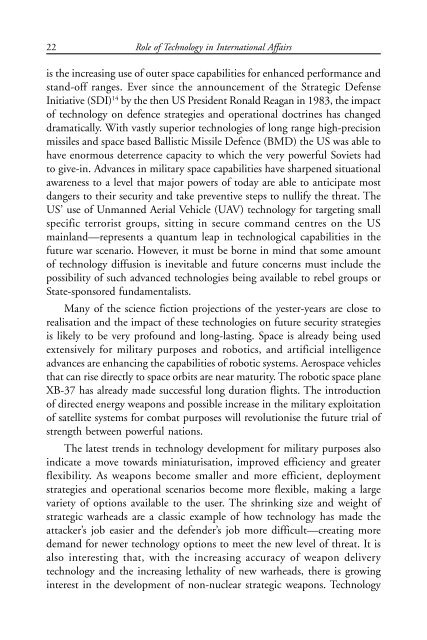ROLE OF TECHNOLOGY INTERNATIONAL AFFAIRS
book_role-of-technology-in-international-affairs_a-mallik_1
book_role-of-technology-in-international-affairs_a-mallik_1
You also want an ePaper? Increase the reach of your titles
YUMPU automatically turns print PDFs into web optimized ePapers that Google loves.
22<br />
Role of Technology in International Affairs<br />
is the increasing use of outer space capabilities for enhanced performance and<br />
stand-off ranges. Ever since the announcement of the Strategic Defense<br />
Initiative (SDI) 14 by the then US President Ronald Reagan in 1983, the impact<br />
of technology on defence strategies and operational doctrines has changed<br />
dramatically. With vastly superior technologies of long range high-precision<br />
missiles and space based Ballistic Missile Defence (BMD) the US was able to<br />
have enormous deterrence capacity to which the very powerful Soviets had<br />
to give-in. Advances in military space capabilities have sharpened situational<br />
awareness to a level that major powers of today are able to anticipate most<br />
dangers to their security and take preventive steps to nullify the threat. The<br />
US’ use of Unmanned Aerial Vehicle (UAV) technology for targeting small<br />
specific terrorist groups, sitting in secure command centres on the US<br />
mainland—represents a quantum leap in technological capabilities in the<br />
future war scenario. However, it must be borne in mind that some amount<br />
of technology diffusion is inevitable and future concerns must include the<br />
possibility of such advanced technologies being available to rebel groups or<br />
State-sponsored fundamentalists.<br />
Many of the science fiction projections of the yester-years are close to<br />
realisation and the impact of these technologies on future security strategies<br />
is likely to be very profound and long-lasting. Space is already being used<br />
extensively for military purposes and robotics, and artificial intelligence<br />
advances are enhancing the capabilities of robotic systems. Aerospace vehicles<br />
that can rise directly to space orbits are near maturity. The robotic space plane<br />
XB-37 has already made successful long duration flights. The introduction<br />
of directed energy weapons and possible increase in the military exploitation<br />
of satellite systems for combat purposes will revolutionise the future trial of<br />
strength between powerful nations.<br />
The latest trends in technology development for military purposes also<br />
indicate a move towards miniaturisation, improved efficiency and greater<br />
flexibility. As weapons become smaller and more efficient, deployment<br />
strategies and operational scenarios become more flexible, making a large<br />
variety of options available to the user. The shrinking size and weight of<br />
strategic warheads are a classic example of how technology has made the<br />
attacker’s job easier and the defender’s job more difficult—creating more<br />
demand for newer technology options to meet the new level of threat. It is<br />
also interesting that, with the increasing accuracy of weapon delivery<br />
technology and the increasing lethality of new warheads, there is growing<br />
interest in the development of non-nuclear strategic weapons. Technology


